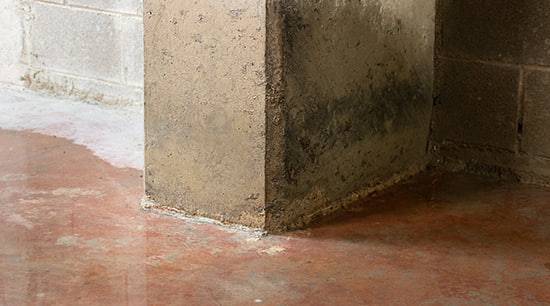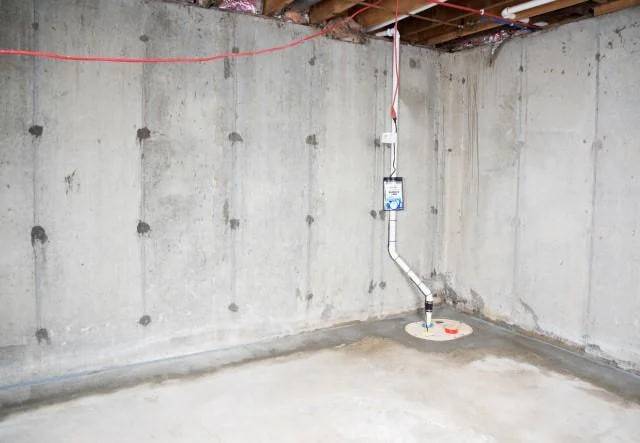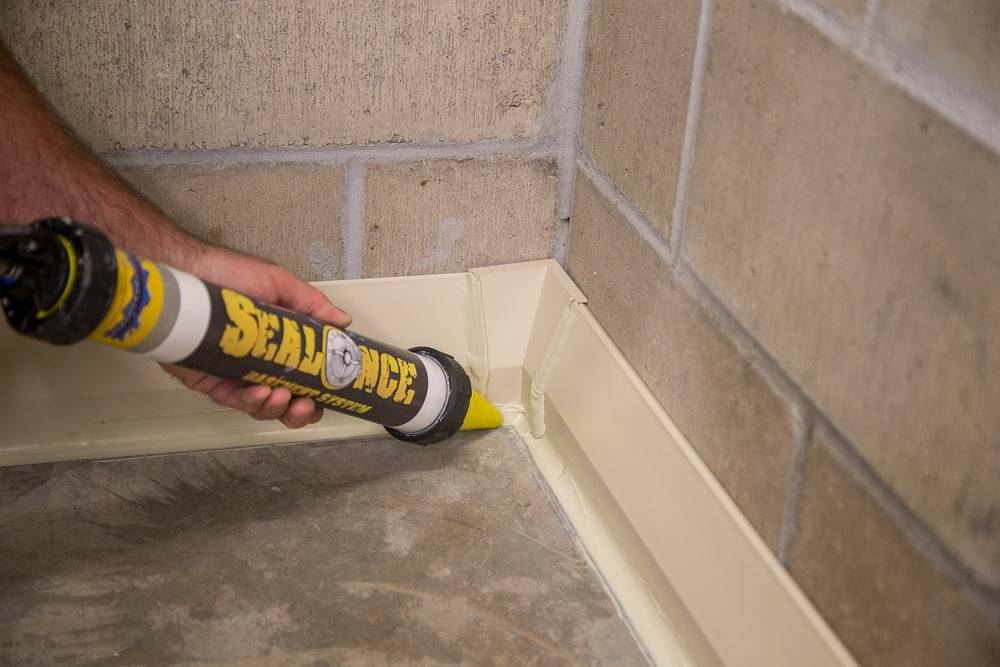Does the mere mention of spring rains send shivers down your spine as you envision a damp, musty basement? Fear not, homeowner! This comprehensive guide is your key to unlocking a dry and healthy basement, ready to be transformed into the space of your dreams. Whether you’re battling persistent leaks, tackling seasonal dampness, or simply seeking preventative measures, we’ll equip you with the knowledge and solutions to turn your basement into a haven, not a headache.
This guide delves into both the why and how of basement waterproofing, empowering you to:
- Identify the signs of water intrusion and understand the potential damage it can cause.
- Explore a range of waterproofing methods, from exterior drainage solutions to interior sealing techniques, catered to your specific needs and budget.
- Uncover DIY options for the handy homeowner, alongside expert advice on when to call in the professionals.
- Gain insight into maintenance strategies to ensure your basement stays dry and healthy for years to come.
So, grab your tools (or your phone to call a contractor!), roll up your sleeves, and let’s embark on this journey to a waterproofed basement you can truly enjoy!
Early Detection is Key: Recognizing the Signs of Water Intrusion in Your Basement
Before diving into waterproofing solutions, let’s equip you with the eagle eye of a basement detective! Recognizing the telltale signs of water intrusion is crucial to nip the problem in the bud and prevent costly damage. Here’s what to keep an eye out for:
Visual Clues:
- Moisture & Dampness: This is the most basic indicator. Check walls, floors, and ceilings for any signs of dampness, including wet patches, sweating concrete, or visible water trails. Don’t forget to peek behind stored items and under furniture.
- Water Stains & Discoloration: Brownish streaks, watermarks, or even white mineral deposits (efflorescence) are red flags. Look for them on walls, floors, windowsills, and around pipes.
- Cracks & Crumbling: Cracks in foundation walls, floors, or around windows and doors can become entry points for water. Pay attention to their size, location, and any recent growth.
- Mold & Mildew: These unwelcome guests thrive in damp environments. Their presence signifies excess moisture and potential water intrusion.
Sensory Signals:
- Musty Odors: A persistent earthy or musty smell is a strong indicator of dampness and potential mold growth.
- Condensation: Notice excessive condensation on windows, pipes, or walls? This points to high humidity, often caused by water vapor trapped in the basement.
Beyond the Obvious:
- Unexplained Puddles: Standing water, even after heavy rain, is a major red flag. Pay attention to areas near sump pumps, drains, or appliances.
- Insect Activity: Silverfish, centipedes, and other moisture-loving creatures might set up camp in your damp basement.
- Rising Damp: This occurs when groundwater pressure forces water up through foundation walls and floors. Look for dampness at the lowest points of your basement.
Understanding the Potential Damage:
Ignoring water intrusion can lead to a cascade of problems:
- Structural Damage: Foundation cracks can worsen, leading to uneven floors, sagging walls, and even structural instability.
- Mold Growth: This poses health risks and can damage belongings.
- Rot & Decay: Wooden floor joists, beams, and stored items can succumb to rot, requiring costly repairs and replacements.
- Increased Humidity: This can create an uncomfortable living environment and exacerbate allergies and respiratory issues.
Remember, early detection is key! By being vigilant and addressing water intrusion promptly, you can save yourself from these costly and harmful consequences.
Conquering the Leak: A Spectrum of Waterproofing Solutions
Now that you’re armed with the knowledge to identify water intrusion, let’s explore the arsenal of waterproofing weapons at your disposal! Remember, the best approach depends on the severity of the problem, your budget, and the specific characteristics of your basement.
Exterior Drainage Solutions:
- French Drains: These trenches collect water around your foundation and redirect it away from your home. Ideal for high water table areas or basements with perimeter leaks.
- Exterior Waterproofing Membranes: Applied directly to the foundation walls, these membranes create a watertight barrier. Often used in conjunction with drainage systems.
- Foundation Crack Repair: Sealing cracks in your foundation walls with specialized sealants can prevent water infiltration.
Interior Sealing Techniques:
- Interior Waterproofing Membranes: Similar to exterior membranes, these are applied to the interior basement walls to create a barrier. Suitable for moderate moisture problems or when excavation is impractical.
- Epoxy Injection: For small cracks, injecting epoxy resin into them forms a waterproof seal.
- Sump Pumps & Drainage Systems: Installed in the lowest point of your basement, these pumps collect and discharge water that seeps through walls or floors. Ideal for basements with below-grade floors or recurring water issues.
Additional Considerations:
- Grading & Landscaping: Proper grading around your home ensures water flows away from the foundation.
- Gutter Systems: Ensure your gutters are functional and direct water away from the foundation.
- Ventilation & Dehumidification: Addressing excess moisture in the air can prevent condensation and mold growth.
Get Your Hands Dirty (Safely!): DIY Basement Waterproofing Options
Calling in the pros for basement waterproofing is always a solid choice, but if you’re a handy homeowner and the issue seems manageable, here are some DIY options to consider:
DIY-Friendly Solutions:
- Sealing Cracks and Leaks: For small cracks (less than 1/4 inch wide), use hydraulic cement or specialized crack sealants following manufacturer instructions. Remember, this is a temporary fix for minor seepage, not major structural cracks.
- Interior Waterproofing Paint: Apply waterproof paint on concrete walls after addressing major cracks and ensuring the surface is clean and dry. This can add an extra layer of protection against minor moisture issues.
- Dehumidification: Invest in a portable dehumidifier to control excess moisture in the air, preventing condensation and mold growth.
- Grading and Drainage: Improve the grading around your house to ensure water flows away from the foundation. Clean and extend gutters to direct rainwater farther away.
- Sealing Windows and Doors: Check for gaps around windows and doors and seal them with caulk or weatherstripping to prevent water entry.
Expert Advice: When to Call in the Pros:
While these DIY options are helpful for minor issues, remember:
- Seek professional help for:
- Extensive water intrusion, major foundation cracks, or structural concerns.
- Complex drainage systems like French drains or sump pump installations.
- Unfamiliar techniques or requiring specialized equipment.
- Consult a professional when:
- You’re unsure about the source or severity of the water problem.
- You lack the confidence or experience for specific tasks.
- You want a long-term, guaranteed solution and peace of mind.
Maintaining the Magic: Keeping Your Basement Dry and Healthy
Once you’ve conquered the leak and implemented your chosen waterproofing solution, don’t rest on your laurels! Proactive maintenance is key to ensuring your basement stays dry and healthy for years to come. Here are some key strategies:
Regular Inspections:
- Visual Checks: Conduct monthly inspections for any signs of water intrusion, including dampness, leaks, cracks, or mold growth. Pay attention to areas near sump pumps, drains, and foundation walls.
- Drainage System Maintenance: Clean gutters and downspouts regularly to ensure proper water flow away from the foundation. If you have a sump pump:
- Test it monthly by pouring water into the sump pit and ensuring it turns on and pumps out efficiently.
- Clean the pump and pit annually, removing debris that can clog the system.
- Consider installing a battery backup system for uninterrupted operation during power outages.
Moisture Control:
- Ventilation: Run exhaust fans in bathrooms and laundry rooms to vent moisture-laden air outside. Consider installing a whole-house dehumidifier if your basement struggles with high humidity.
- Drying and Storage: Dry any spills promptly and avoid storing water-sensitive items in the basement. Ensure proper ventilation around stored items to prevent moisture buildup.
Grading and Landscaping:
- Maintain proper grading: The ground around your foundation should slope away from the house to direct water runoff. Address any dips or low spots that collect water.
- Clear vegetation: Trim trees and shrubs close to the foundation to prevent them from blocking gutters or directing water towards the house.
Additional Tips:
- Address leaks promptly: Even small leaks can lead to bigger problems if left unattended. Don’t delay in fixing any leaks you discover during your inspections.
- Consider professional inspections: Schedule periodic inspections by a qualified waterproofing professional to identify any potential issues before they become major problems.
- Stay informed: Keep up-to-date on new waterproofing technologies and maintenance practices to ensure your basement remains protected.
Conclusion: A Dry Basement, a Happy Home
Congratulations! You’ve embarked on your journey to a dry and healthy basement. Armed with the knowledge of identifying water intrusion, exploring waterproofing solutions, and implementing maintenance strategies, you’re well on your way to transforming that damp space into a valuable asset to your home.
Remember, waterproofing isn’t a one-time fix; it’s a commitment to vigilance and proactive care. By addressing the issue head-on, choosing the right approach, and maintaining your efforts, you can create a dry and healthy haven for years to come.
Whether you tackled the project yourself or enlisted the help of professionals, you’ve invested in the peace of mind that comes with a waterproof basement. Now, go forth and enjoy the possibilities your transformed space holds!
And remember, if any questions or concerns arise along the way, don’t hesitate to seek professional guidance. A dry basement is just a step away, and the benefits are well worth the effort. So, dive in with confidence, and enjoy the journey to a truly dry and enjoyable living space!
Basement Waterproofing FAQs:
Can I seal my basement myself?
Minor cracks and leaks can be addressed with DIY solutions like sealant or hydraulic cement. However, complex issues or major structural concerns require professional expertise.
What are the best DIY options for basement waterproofing?
Sealing small cracks, applying waterproof paint, improving grading, and maintaining gutters are some DIY possibilities.
When should I call a professional for basement waterproofing?
If you’re unsure of the cause or severity of the problem, lack experience, or need complex solutions like French drains or sump pumps, consult a professional.
How can I maintain a dry and healthy basement?
Regularly inspect for leaks, clean gutters and downspouts, control moisture with ventilation and dehumidification, maintain proper grading, and address leaks promptly.
How often should I have my basement waterproofing system inspected?
Consult a professional for their recommendation, but annual inspections are generally a good practice.
What are some new technologies in basement waterproofing?
Stay informed about advancements in membranes, sealants, drainage systems, and dehumidifiers to ensure your maintenance practices are up-to-date.
Does finishing my basement require additional waterproofing?
Yes, even finished basements need proper waterproofing to prevent future moisture issues.
What are the health risks associated with a damp basement?
Mold growth due to moisture can trigger allergies and respiratory problems.
How can I increase the value of my home with a dry basement?
A dry and finished basement adds usable living space and increases your home’s overall value.




